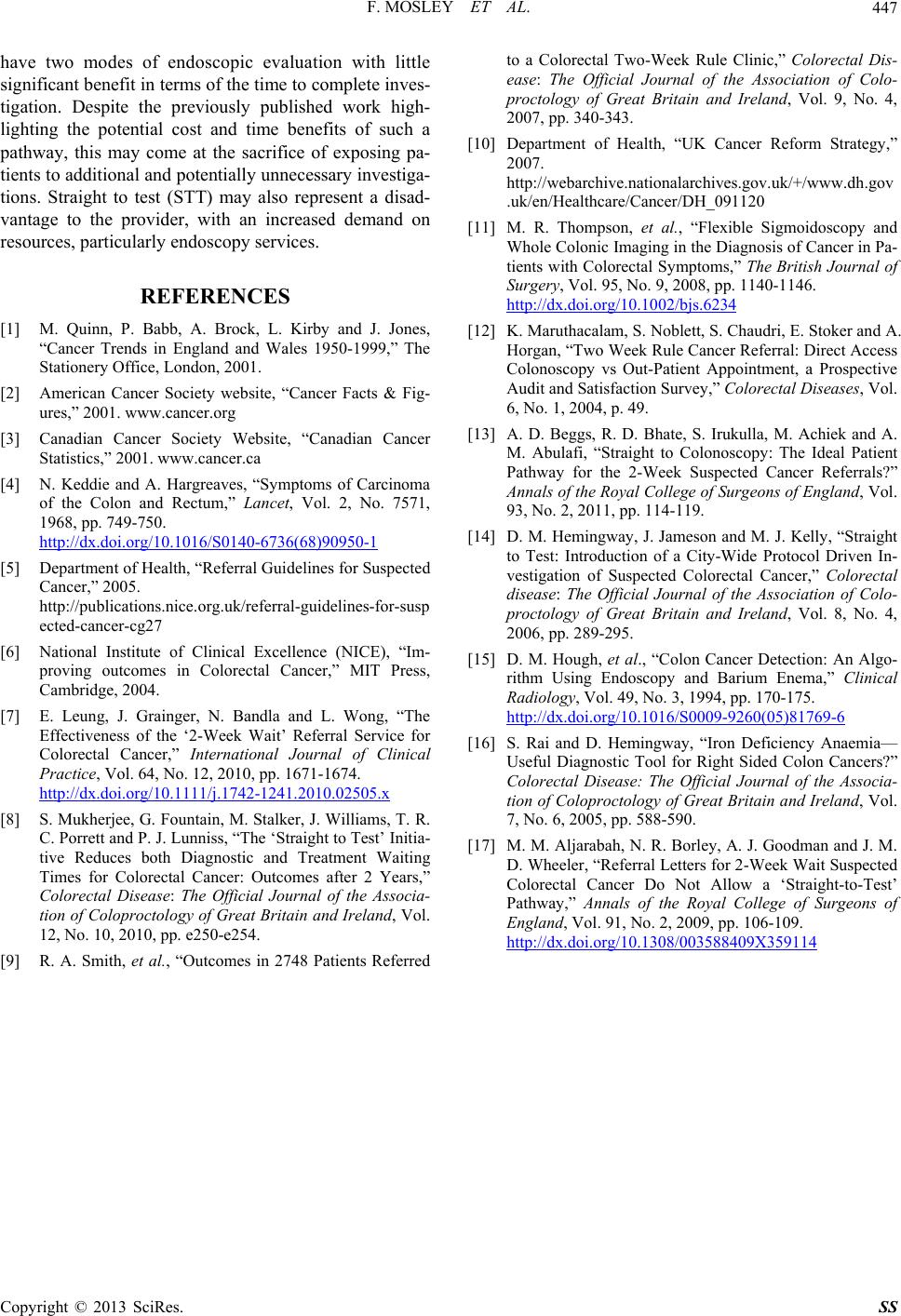
F. MOSLEY ET AL. 447
have two modes of endoscopic evaluation with little
significant benefit in terms of the time to complete inves-
tigation. Despite the previously published work high-
lighting the potential cost and time benefits of such a
pathway, this may come at the sacrifice of exposing pa-
tients to additional and potentially unnecessary investiga-
tions. Straight to test (STT) may also represent a disad-
vantage to the provider, with an increased demand on
resources, particularly endoscopy services.
REFERENCES
[1] M. Quinn, P. Babb, A. Brock, L. Kirby and J. Jones,
“Cancer Trends in England and Wales 1950-1999,” The
Stationery Office, London, 2001.
[2] American Cancer Society website, “Cancer Facts & Fig-
ures,” 2001. www.cancer.org
[3] Canadian Cancer Society Website, “Canadian Cancer
Statistics,” 2001. www.cancer.ca
[4] N. Keddie and A. Hargreaves, “Symptoms of Carcinoma
of the Colon and Rectum,” Lancet, Vol. 2, No. 7571,
1968, pp. 749-750.
http://dx.doi.org/10.1016/S0140-6736(68)90950-1
[5] Department of Health, “Referral Guidelines for Suspected
Cancer,” 2005.
http://publications.nice.org.uk/referral-guidelines-for-susp
ected-cancer-cg27
[6] National Institute of Clinical Excellence (NICE), “Im-
proving outcomes in Colorectal Cancer,” MIT Press,
Cambridge, 2004.
[7] E. Leung, J. Grainger, N. Bandla and L. Wong, “The
Effectiveness of the ‘2-Week Wait’ Referral Service for
Colorectal Cancer,” International Journal of Clinical
Practice, Vol. 64, No. 12, 2010, pp. 1671-1674.
http://dx.doi.org/10.1111/j.1742-1241.2010.02505.x
[8] S. Mukherjee, G. Fountain, M. Stalker, J. Williams, T. R.
C. Porrett and P. J. Lunniss, “The ‘Straight to Test’ Initia-
tive Reduces both Diagnostic and Treatment Waiting
Times for Colorectal Cancer: Outcomes after 2 Years,”
Colorectal Disease: The Official Journal of the Associa-
tion of Coloproctology of Great Britain and Ireland, Vol.
12, No. 10, 2010, pp. e250-e254.
[9] R. A. Smith, et al., “Outcomes in 2748 Patients Referred
to a Colorectal Two-Week Rule Clinic,” Colorectal Dis-
ease: The Official Journal of the Association of Colo-
proctology of Great Britain and Ireland, Vol. 9, No. 4,
2007, pp. 340-343.
[10] Department of Health, “UK Cancer Reform Strategy,”
2007.
http://webarchive.nationalarchives.gov.uk/+/www.dh.gov
.uk/en/Healthcare/Cancer/DH_091120
[11] M. R. Thompson, et al., “Flexible Sigmoidoscopy and
Whole Colonic Imaging in the Diagnosis of Cancer in Pa-
tients with Colorectal Symptoms,” The British Journal of
Surgery, Vol. 95, No. 9, 2008, pp. 1140-1146.
http://dx.doi.org/10.1002/bjs.6234
[12] K. Maruthacalam, S. Noblett, S. Chaudri, E. Stoker and A.
Horgan, “Two Week Rule Cancer Referral: Direct Access
Colonoscopy vs Out-Patient Appointment, a Prospective
Audit and Satisfaction Survey,” Colorectal Diseases, Vol.
6, No. 1, 2004, p. 49.
[13] A. D. Beggs, R. D. Bhate, S. Irukulla, M. Achiek and A.
M. Abulafi, “Straight to Colonoscopy: The Ideal Patient
Pathway for the 2-Week Suspected Cancer Referrals?”
Annals of the Royal College of Surgeons of England, Vol.
93, No. 2, 2011, pp. 114-119.
[14] D. M. Hemingway, J. Jameson and M. J. Kelly, “Straight
to Test: Introduction of a City-Wide Protocol Driven In-
vestigation of Suspected Colorectal Cancer,” Colorectal
disease: The Official Journal of the Association of Colo-
proctology of Great Britain and Ireland, Vol. 8, No. 4,
2006, pp. 289-295.
[15] D. M. Hough, et al., “Colon Cancer Detection: An Algo-
rithm Using Endoscopy and Barium Enema,” Clinical
Radiology, Vol. 49, No. 3, 1994, pp. 170-175.
http://dx.doi.org/10.1016/S0009-9260(05)81769-6
[16] S. Rai and D. Hemingway, “Iron Deficiency Anaemia—
Useful Diagnostic Tool for Right Sided Colon Cancers?”
Colorectal Disease: The Official Journal of the Associa-
tion of Coloproctology of Great Britain and Ireland, Vol.
7, No. 6, 2005, pp. 588-590.
[17] M. M. Aljarabah, N. R. Borley, A. J. Goodman and J. M.
D. Wheeler, “Referral Letters for 2-Week Wait Suspected
Colorectal Cancer Do Not Allow a ‘Straight-to-Test’
Pathway,” Annals of the Royal College of Surgeons of
England, Vol. 91, No. 2, 2009, pp. 106-109.
http://dx.doi.org/10.1308/003588409X359114
Copyright © 2013 SciRes. SS